Management and Organization in Global Environment Report: Analysis
VerifiedAdded on 2020/03/01
|8
|1434
|124
Report
AI Summary
This report delves into the principles of management and organization within a global context, specifically focusing on the application of Taylorism and its contemporary relevance. It examines how Taylor's scientific management principles are adapted and applied across different industries, including call centers and fast-food chains, and contrasts these practices with alternative approaches, such as those employed by companies like Google. The report also analyzes the cultural differences in management practices, particularly comparing Australia and Singapore through Geert Hofstede's 5-D model. This includes an examination of power distance, individualism, masculinity, uncertainty avoidance, long-term orientation, and indulgence, to highlight the impact of cultural dimensions on organizational behavior and management strategies. The analysis also includes how these dimensions reflect in the real situations of the society and business world of the country.
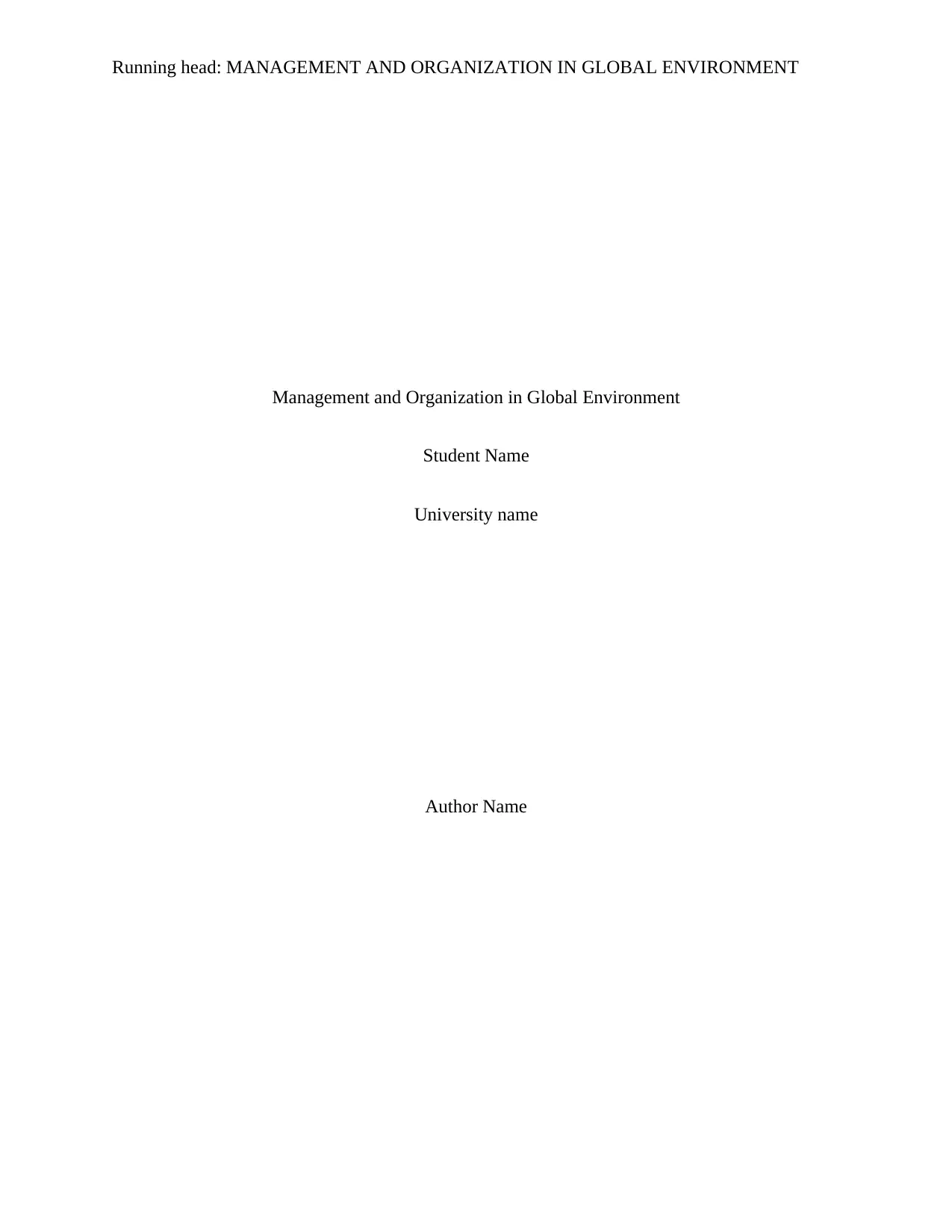
Running head: MANAGEMENT AND ORGANIZATION IN GLOBAL ENVIRONMENT
Management and Organization in Global Environment
Student Name
University name
Author Name
Management and Organization in Global Environment
Student Name
University name
Author Name
Paraphrase This Document
Need a fresh take? Get an instant paraphrase of this document with our AI Paraphraser
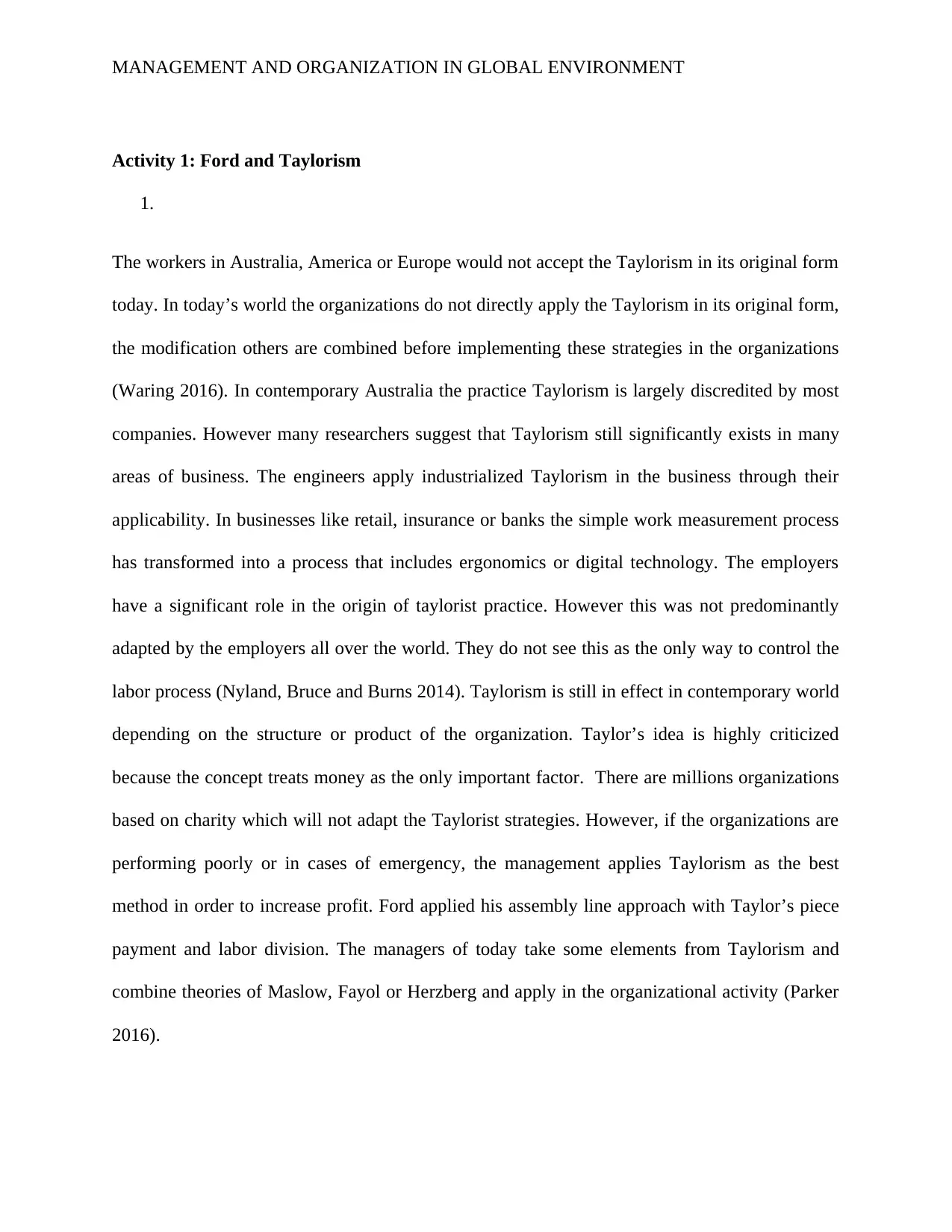
MANAGEMENT AND ORGANIZATION IN GLOBAL ENVIRONMENT
Activity 1: Ford and Taylorism
1.
The workers in Australia, America or Europe would not accept the Taylorism in its original form
today. In today’s world the organizations do not directly apply the Taylorism in its original form,
the modification others are combined before implementing these strategies in the organizations
(Waring 2016). In contemporary Australia the practice Taylorism is largely discredited by most
companies. However many researchers suggest that Taylorism still significantly exists in many
areas of business. The engineers apply industrialized Taylorism in the business through their
applicability. In businesses like retail, insurance or banks the simple work measurement process
has transformed into a process that includes ergonomics or digital technology. The employers
have a significant role in the origin of taylorist practice. However this was not predominantly
adapted by the employers all over the world. They do not see this as the only way to control the
labor process (Nyland, Bruce and Burns 2014). Taylorism is still in effect in contemporary world
depending on the structure or product of the organization. Taylor’s idea is highly criticized
because the concept treats money as the only important factor. There are millions organizations
based on charity which will not adapt the Taylorist strategies. However, if the organizations are
performing poorly or in cases of emergency, the management applies Taylorism as the best
method in order to increase profit. Ford applied his assembly line approach with Taylor’s piece
payment and labor division. The managers of today take some elements from Taylorism and
combine theories of Maslow, Fayol or Herzberg and apply in the organizational activity (Parker
2016).
Activity 1: Ford and Taylorism
1.
The workers in Australia, America or Europe would not accept the Taylorism in its original form
today. In today’s world the organizations do not directly apply the Taylorism in its original form,
the modification others are combined before implementing these strategies in the organizations
(Waring 2016). In contemporary Australia the practice Taylorism is largely discredited by most
companies. However many researchers suggest that Taylorism still significantly exists in many
areas of business. The engineers apply industrialized Taylorism in the business through their
applicability. In businesses like retail, insurance or banks the simple work measurement process
has transformed into a process that includes ergonomics or digital technology. The employers
have a significant role in the origin of taylorist practice. However this was not predominantly
adapted by the employers all over the world. They do not see this as the only way to control the
labor process (Nyland, Bruce and Burns 2014). Taylorism is still in effect in contemporary world
depending on the structure or product of the organization. Taylor’s idea is highly criticized
because the concept treats money as the only important factor. There are millions organizations
based on charity which will not adapt the Taylorist strategies. However, if the organizations are
performing poorly or in cases of emergency, the management applies Taylorism as the best
method in order to increase profit. Ford applied his assembly line approach with Taylor’s piece
payment and labor division. The managers of today take some elements from Taylorism and
combine theories of Maslow, Fayol or Herzberg and apply in the organizational activity (Parker
2016).
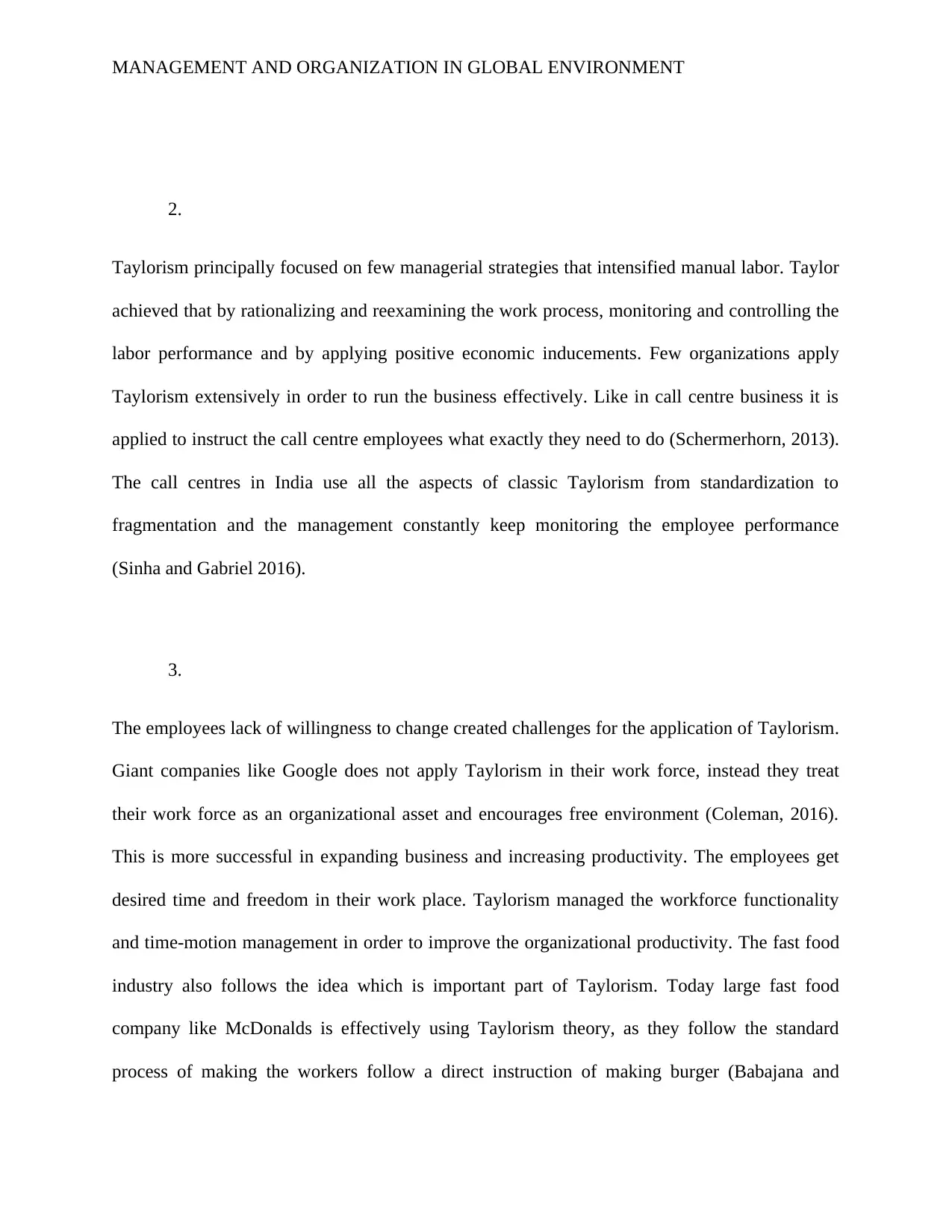
MANAGEMENT AND ORGANIZATION IN GLOBAL ENVIRONMENT
2.
Taylorism principally focused on few managerial strategies that intensified manual labor. Taylor
achieved that by rationalizing and reexamining the work process, monitoring and controlling the
labor performance and by applying positive economic inducements. Few organizations apply
Taylorism extensively in order to run the business effectively. Like in call centre business it is
applied to instruct the call centre employees what exactly they need to do (Schermerhorn, 2013).
The call centres in India use all the aspects of classic Taylorism from standardization to
fragmentation and the management constantly keep monitoring the employee performance
(Sinha and Gabriel 2016).
3.
The employees lack of willingness to change created challenges for the application of Taylorism.
Giant companies like Google does not apply Taylorism in their work force, instead they treat
their work force as an organizational asset and encourages free environment (Coleman, 2016).
This is more successful in expanding business and increasing productivity. The employees get
desired time and freedom in their work place. Taylorism managed the workforce functionality
and time-motion management in order to improve the organizational productivity. The fast food
industry also follows the idea which is important part of Taylorism. Today large fast food
company like McDonalds is effectively using Taylorism theory, as they follow the standard
process of making the workers follow a direct instruction of making burger (Babajana and
2.
Taylorism principally focused on few managerial strategies that intensified manual labor. Taylor
achieved that by rationalizing and reexamining the work process, monitoring and controlling the
labor performance and by applying positive economic inducements. Few organizations apply
Taylorism extensively in order to run the business effectively. Like in call centre business it is
applied to instruct the call centre employees what exactly they need to do (Schermerhorn, 2013).
The call centres in India use all the aspects of classic Taylorism from standardization to
fragmentation and the management constantly keep monitoring the employee performance
(Sinha and Gabriel 2016).
3.
The employees lack of willingness to change created challenges for the application of Taylorism.
Giant companies like Google does not apply Taylorism in their work force, instead they treat
their work force as an organizational asset and encourages free environment (Coleman, 2016).
This is more successful in expanding business and increasing productivity. The employees get
desired time and freedom in their work place. Taylorism managed the workforce functionality
and time-motion management in order to improve the organizational productivity. The fast food
industry also follows the idea which is important part of Taylorism. Today large fast food
company like McDonalds is effectively using Taylorism theory, as they follow the standard
process of making the workers follow a direct instruction of making burger (Babajana and
⊘ This is a preview!⊘
Do you want full access?
Subscribe today to unlock all pages.

Trusted by 1+ million students worldwide
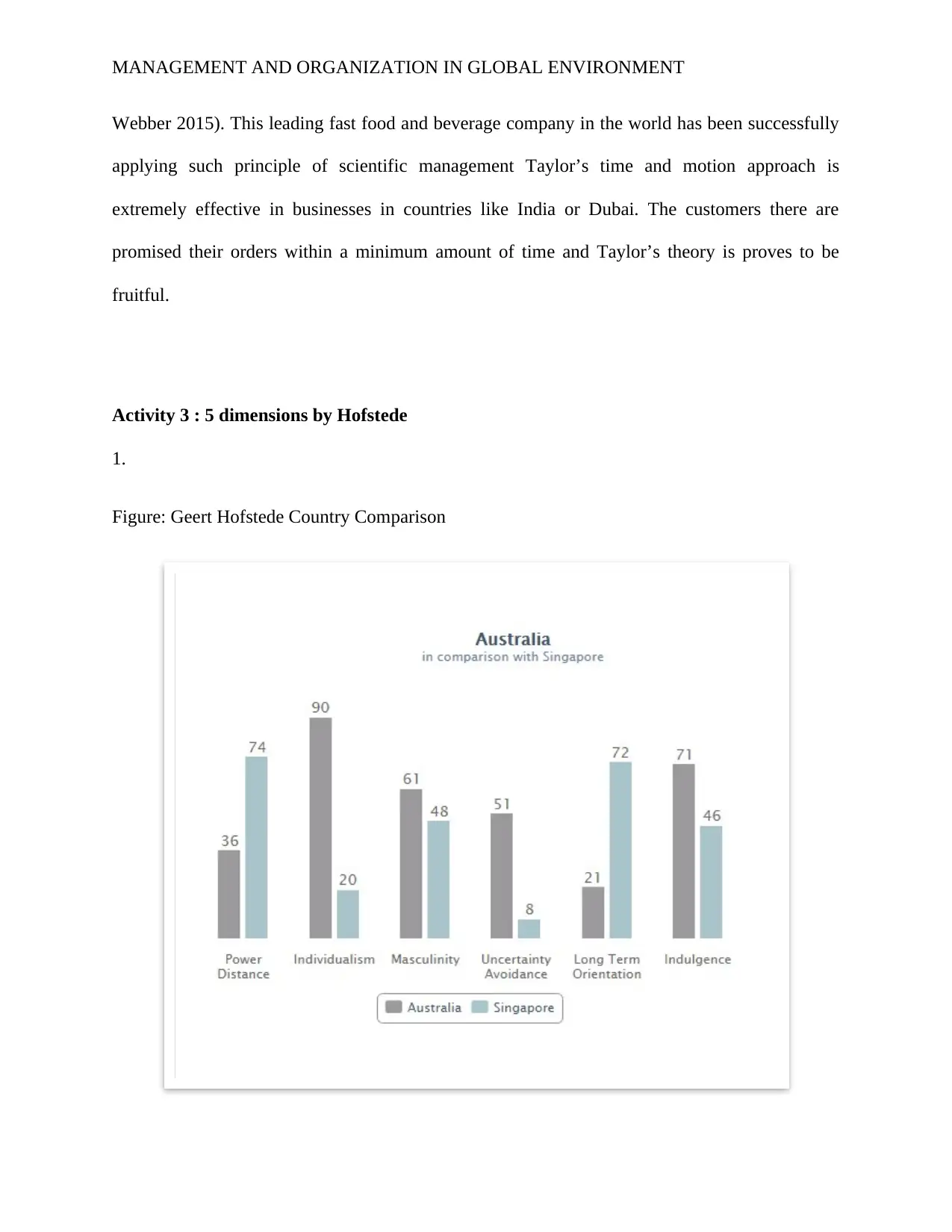
MANAGEMENT AND ORGANIZATION IN GLOBAL ENVIRONMENT
Webber 2015). This leading fast food and beverage company in the world has been successfully
applying such principle of scientific management Taylor’s time and motion approach is
extremely effective in businesses in countries like India or Dubai. The customers there are
promised their orders within a minimum amount of time and Taylor’s theory is proves to be
fruitful.
Activity 3 : 5 dimensions by Hofstede
1.
Figure: Geert Hofstede Country Comparison
Webber 2015). This leading fast food and beverage company in the world has been successfully
applying such principle of scientific management Taylor’s time and motion approach is
extremely effective in businesses in countries like India or Dubai. The customers there are
promised their orders within a minimum amount of time and Taylor’s theory is proves to be
fruitful.
Activity 3 : 5 dimensions by Hofstede
1.
Figure: Geert Hofstede Country Comparison
Paraphrase This Document
Need a fresh take? Get an instant paraphrase of this document with our AI Paraphraser
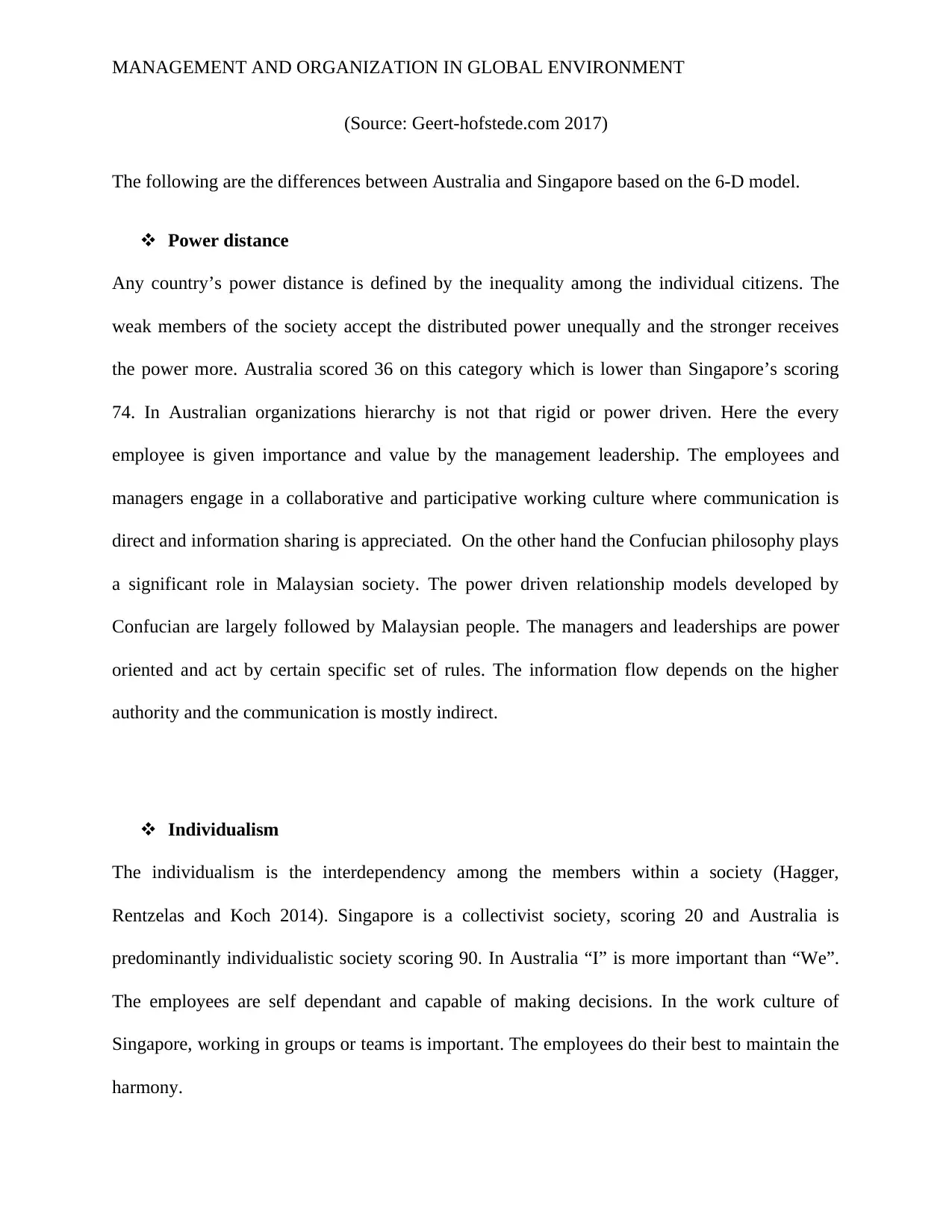
MANAGEMENT AND ORGANIZATION IN GLOBAL ENVIRONMENT
(Source: Geert-hofstede.com 2017)
The following are the differences between Australia and Singapore based on the 6-D model.
Power distance
Any country’s power distance is defined by the inequality among the individual citizens. The
weak members of the society accept the distributed power unequally and the stronger receives
the power more. Australia scored 36 on this category which is lower than Singapore’s scoring
74. In Australian organizations hierarchy is not that rigid or power driven. Here the every
employee is given importance and value by the management leadership. The employees and
managers engage in a collaborative and participative working culture where communication is
direct and information sharing is appreciated. On the other hand the Confucian philosophy plays
a significant role in Malaysian society. The power driven relationship models developed by
Confucian are largely followed by Malaysian people. The managers and leaderships are power
oriented and act by certain specific set of rules. The information flow depends on the higher
authority and the communication is mostly indirect.
Individualism
The individualism is the interdependency among the members within a society (Hagger,
Rentzelas and Koch 2014). Singapore is a collectivist society, scoring 20 and Australia is
predominantly individualistic society scoring 90. In Australia “I” is more important than “We”.
The employees are self dependant and capable of making decisions. In the work culture of
Singapore, working in groups or teams is important. The employees do their best to maintain the
harmony.
(Source: Geert-hofstede.com 2017)
The following are the differences between Australia and Singapore based on the 6-D model.
Power distance
Any country’s power distance is defined by the inequality among the individual citizens. The
weak members of the society accept the distributed power unequally and the stronger receives
the power more. Australia scored 36 on this category which is lower than Singapore’s scoring
74. In Australian organizations hierarchy is not that rigid or power driven. Here the every
employee is given importance and value by the management leadership. The employees and
managers engage in a collaborative and participative working culture where communication is
direct and information sharing is appreciated. On the other hand the Confucian philosophy plays
a significant role in Malaysian society. The power driven relationship models developed by
Confucian are largely followed by Malaysian people. The managers and leaderships are power
oriented and act by certain specific set of rules. The information flow depends on the higher
authority and the communication is mostly indirect.
Individualism
The individualism is the interdependency among the members within a society (Hagger,
Rentzelas and Koch 2014). Singapore is a collectivist society, scoring 20 and Australia is
predominantly individualistic society scoring 90. In Australia “I” is more important than “We”.
The employees are self dependant and capable of making decisions. In the work culture of
Singapore, working in groups or teams is important. The employees do their best to maintain the
harmony.
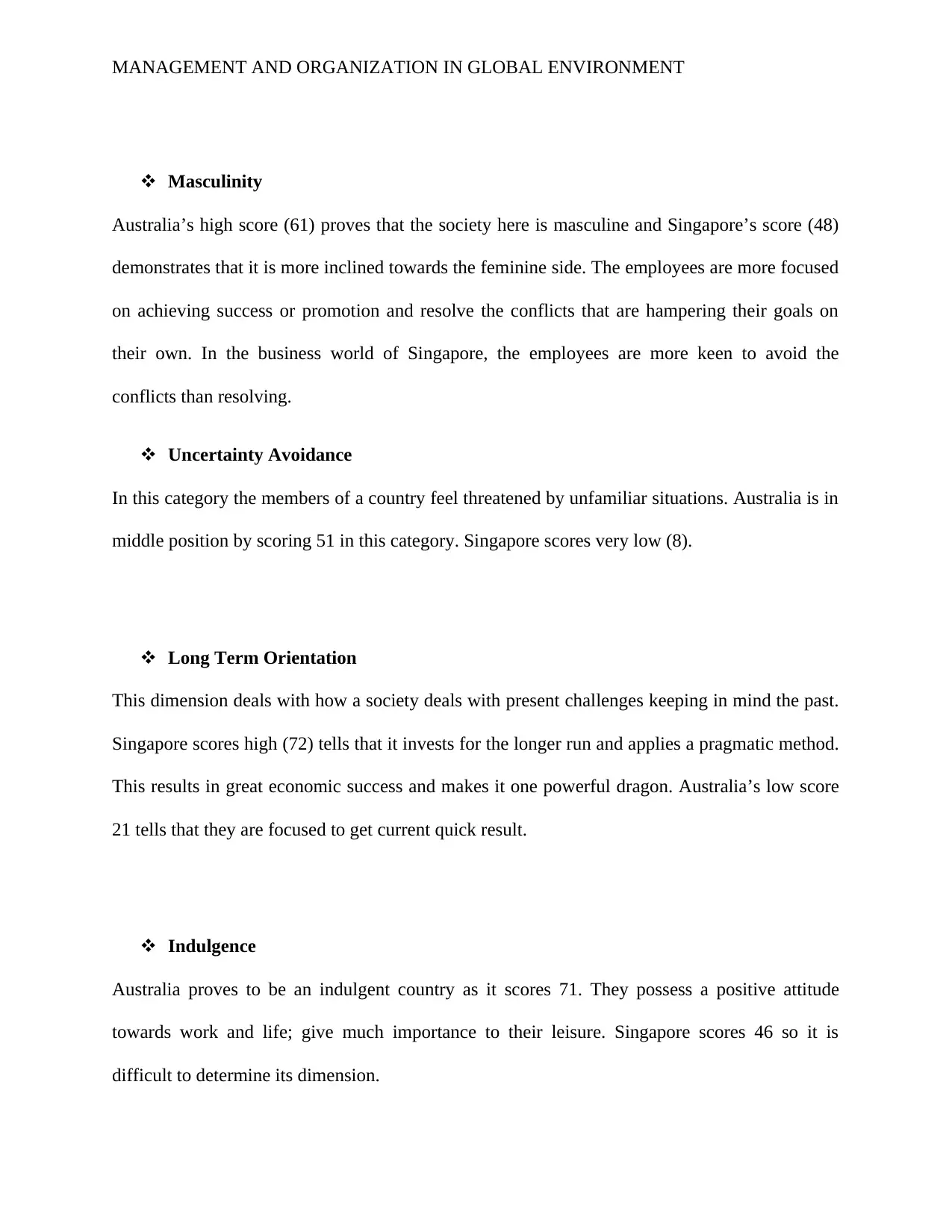
MANAGEMENT AND ORGANIZATION IN GLOBAL ENVIRONMENT
Masculinity
Australia’s high score (61) proves that the society here is masculine and Singapore’s score (48)
demonstrates that it is more inclined towards the feminine side. The employees are more focused
on achieving success or promotion and resolve the conflicts that are hampering their goals on
their own. In the business world of Singapore, the employees are more keen to avoid the
conflicts than resolving.
Uncertainty Avoidance
In this category the members of a country feel threatened by unfamiliar situations. Australia is in
middle position by scoring 51 in this category. Singapore scores very low (8).
Long Term Orientation
This dimension deals with how a society deals with present challenges keeping in mind the past.
Singapore scores high (72) tells that it invests for the longer run and applies a pragmatic method.
This results in great economic success and makes it one powerful dragon. Australia’s low score
21 tells that they are focused to get current quick result.
Indulgence
Australia proves to be an indulgent country as it scores 71. They possess a positive attitude
towards work and life; give much importance to their leisure. Singapore scores 46 so it is
difficult to determine its dimension.
Masculinity
Australia’s high score (61) proves that the society here is masculine and Singapore’s score (48)
demonstrates that it is more inclined towards the feminine side. The employees are more focused
on achieving success or promotion and resolve the conflicts that are hampering their goals on
their own. In the business world of Singapore, the employees are more keen to avoid the
conflicts than resolving.
Uncertainty Avoidance
In this category the members of a country feel threatened by unfamiliar situations. Australia is in
middle position by scoring 51 in this category. Singapore scores very low (8).
Long Term Orientation
This dimension deals with how a society deals with present challenges keeping in mind the past.
Singapore scores high (72) tells that it invests for the longer run and applies a pragmatic method.
This results in great economic success and makes it one powerful dragon. Australia’s low score
21 tells that they are focused to get current quick result.
Indulgence
Australia proves to be an indulgent country as it scores 71. They possess a positive attitude
towards work and life; give much importance to their leisure. Singapore scores 46 so it is
difficult to determine its dimension.
⊘ This is a preview!⊘
Do you want full access?
Subscribe today to unlock all pages.

Trusted by 1+ million students worldwide
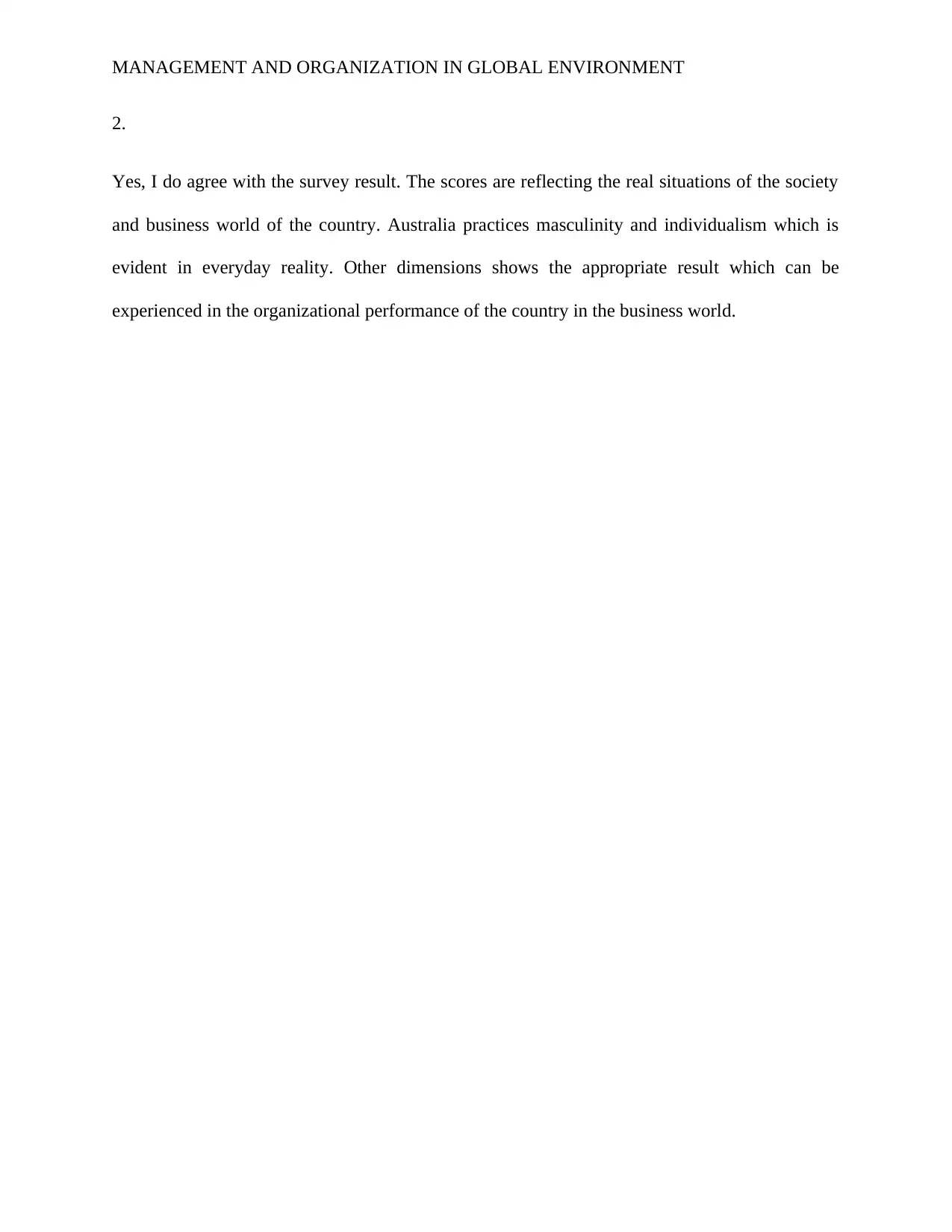
MANAGEMENT AND ORGANIZATION IN GLOBAL ENVIRONMENT
2.
Yes, I do agree with the survey result. The scores are reflecting the real situations of the society
and business world of the country. Australia practices masculinity and individualism which is
evident in everyday reality. Other dimensions shows the appropriate result which can be
experienced in the organizational performance of the country in the business world.
2.
Yes, I do agree with the survey result. The scores are reflecting the real situations of the society
and business world of the country. Australia practices masculinity and individualism which is
evident in everyday reality. Other dimensions shows the appropriate result which can be
experienced in the organizational performance of the country in the business world.
Paraphrase This Document
Need a fresh take? Get an instant paraphrase of this document with our AI Paraphraser
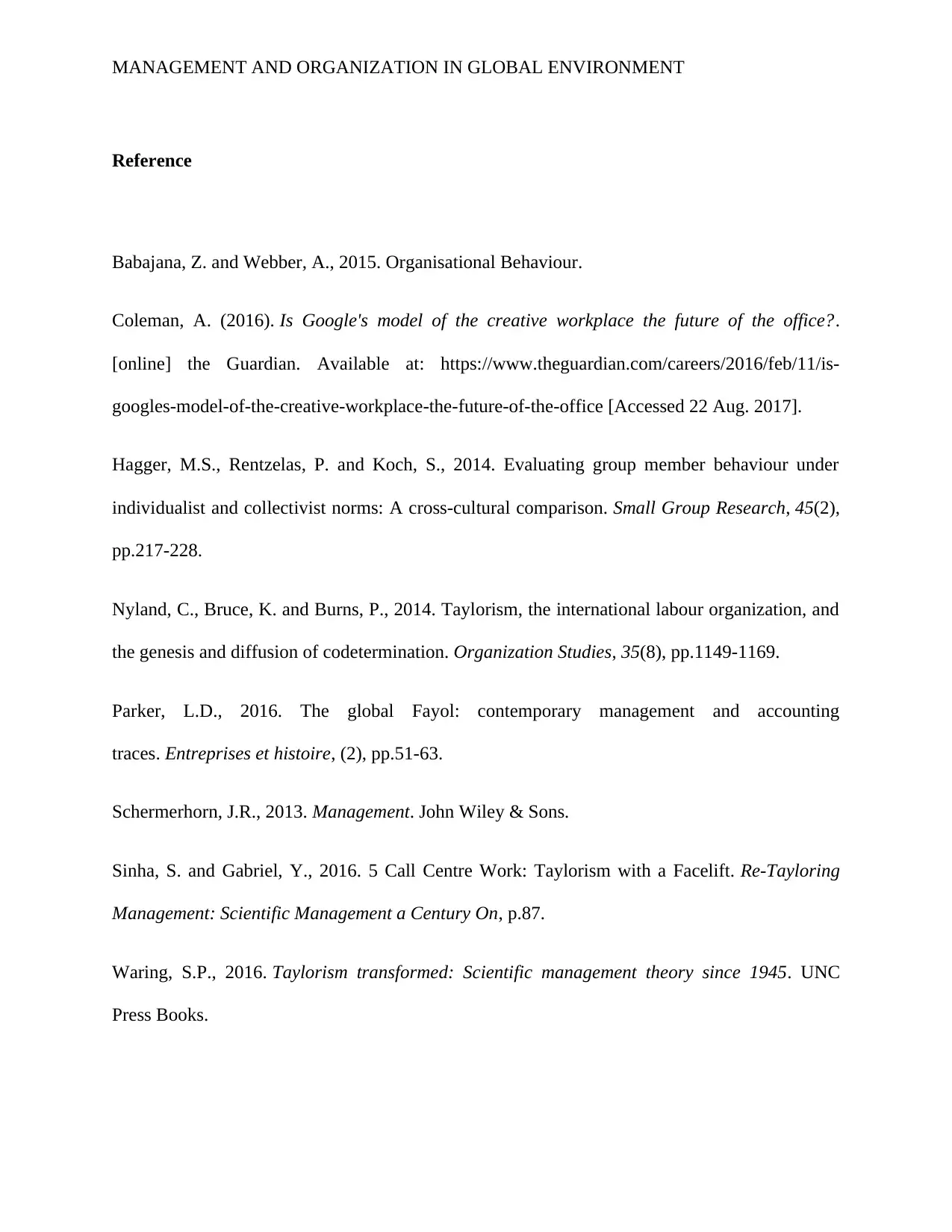
MANAGEMENT AND ORGANIZATION IN GLOBAL ENVIRONMENT
Reference
Babajana, Z. and Webber, A., 2015. Organisational Behaviour.
Coleman, A. (2016). Is Google's model of the creative workplace the future of the office?.
[online] the Guardian. Available at: https://www.theguardian.com/careers/2016/feb/11/is-
googles-model-of-the-creative-workplace-the-future-of-the-office [Accessed 22 Aug. 2017].
Hagger, M.S., Rentzelas, P. and Koch, S., 2014. Evaluating group member behaviour under
individualist and collectivist norms: A cross-cultural comparison. Small Group Research, 45(2),
pp.217-228.
Nyland, C., Bruce, K. and Burns, P., 2014. Taylorism, the international labour organization, and
the genesis and diffusion of codetermination. Organization Studies, 35(8), pp.1149-1169.
Parker, L.D., 2016. The global Fayol: contemporary management and accounting
traces. Entreprises et histoire, (2), pp.51-63.
Schermerhorn, J.R., 2013. Management. John Wiley & Sons.
Sinha, S. and Gabriel, Y., 2016. 5 Call Centre Work: Taylorism with a Facelift. Re-Tayloring
Management: Scientific Management a Century On, p.87.
Waring, S.P., 2016. Taylorism transformed: Scientific management theory since 1945. UNC
Press Books.
Reference
Babajana, Z. and Webber, A., 2015. Organisational Behaviour.
Coleman, A. (2016). Is Google's model of the creative workplace the future of the office?.
[online] the Guardian. Available at: https://www.theguardian.com/careers/2016/feb/11/is-
googles-model-of-the-creative-workplace-the-future-of-the-office [Accessed 22 Aug. 2017].
Hagger, M.S., Rentzelas, P. and Koch, S., 2014. Evaluating group member behaviour under
individualist and collectivist norms: A cross-cultural comparison. Small Group Research, 45(2),
pp.217-228.
Nyland, C., Bruce, K. and Burns, P., 2014. Taylorism, the international labour organization, and
the genesis and diffusion of codetermination. Organization Studies, 35(8), pp.1149-1169.
Parker, L.D., 2016. The global Fayol: contemporary management and accounting
traces. Entreprises et histoire, (2), pp.51-63.
Schermerhorn, J.R., 2013. Management. John Wiley & Sons.
Sinha, S. and Gabriel, Y., 2016. 5 Call Centre Work: Taylorism with a Facelift. Re-Tayloring
Management: Scientific Management a Century On, p.87.
Waring, S.P., 2016. Taylorism transformed: Scientific management theory since 1945. UNC
Press Books.
1 out of 8
Related Documents
Your All-in-One AI-Powered Toolkit for Academic Success.
+13062052269
info@desklib.com
Available 24*7 on WhatsApp / Email
![[object Object]](/_next/static/media/star-bottom.7253800d.svg)
Unlock your academic potential
Copyright © 2020–2025 A2Z Services. All Rights Reserved. Developed and managed by ZUCOL.




